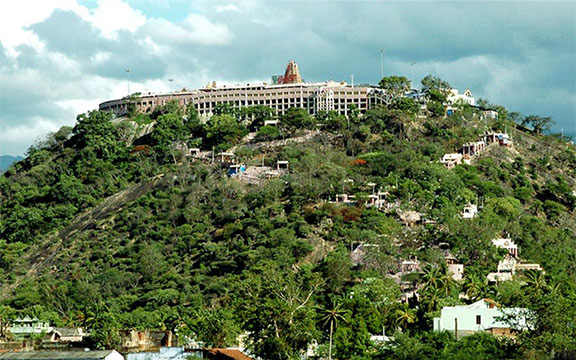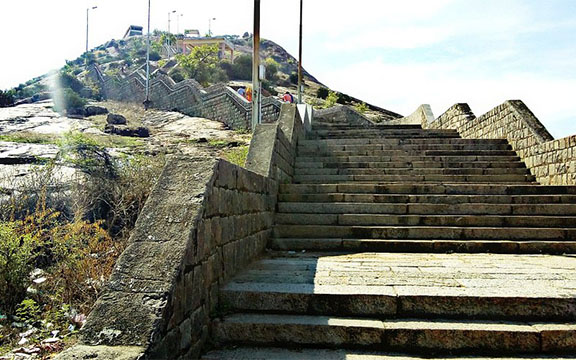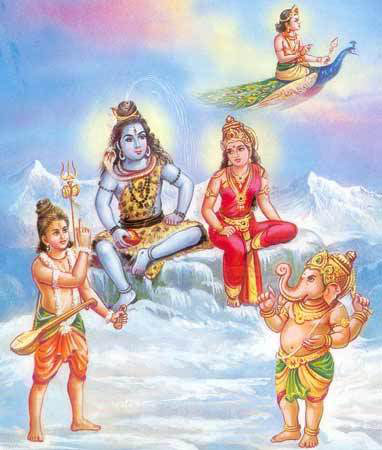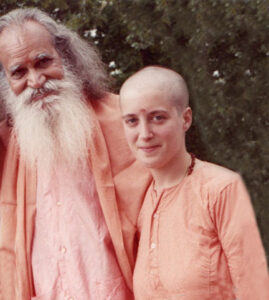
Photo: A view of the Palani hill and temple.
In our last installment, we journeyed back to 1942, when Ramaswamy (later known as Swami Satchidananda) traveled to Palani, a sacred pilgrimage site steeped in centuries of spiritual significance.
This holy place in Tamil Nadu has long been a sanctuary for saints and siddhas (also known as siddhars in South India)—yogis who attained extraordinary spiritual accomplishments. Even today, devoted seekers sense the presence of these enlightened beings in the sanctified atmosphere of this ancient site.
During his time in Palani, Ramaswamy and his fellow sadhus (wandering monks) often experienced visions of these enlightened beings as they traversed the path to and from worship and meditation at the Arulmigu Dhandayuthapani Swamy Thirukoil, the renowned hill temple dedicated to Lord Muruga.
Ramaswamy diligently climbed the hundreds of steps leading to this sacred temple twice, sometimes three times daily, while staying at the ashram of his family’s Guru, Sri Sadhu Swamigal. This rigorous practice not only strengthened his body and disciplined his mind, but also deepened his spiritual resolve. Several decades later Ramaswamy, as Swami Satchidananda, recounted this teaching to his students: “When I was living with Sadhu Swamigal he used to tell me: ‘Don’t worry even if you can’t concentrate that much. It will all come by itself. Just learn to sit quietly. The control of the mind can come later because the mind is a lot subtler than the body.’ See, I can easily control my finger. If I want to close the fist I can easily do it and keep it closed as long as I want. But we can’t control the mind that easily. So apply the will to the physical plane first.” Though Hatha Yoga was not Ramaswamy’s main focus at this time, this teaching is a foreshadowing of how it would be emphasized as a starting point for his Western students and an aid to meditation practice.
He continued to elaborate on this teaching, “Sit quietly in any posture you like. But choose one position and see that you don’t move any part of your body, not even the eyelids. If you close the eyes, keep them closed; if open, keep them open; if halfway, then keep halfway. Any way is okay, but be steady. If you could stay in that one position for three hours, you could easily control the mind. Nothing else would be necessary for you.”

Photo: A view of some of the steps on the steep climb to the hilltop temple.
A Test of Stillness
Ramaswamy earnestly practiced this deep stillness at the temple during his daily meditations. On one such day, while seated in meditation on the veranda of the samadhi shrine of the great Siddhar Bhogar, a pilgrim approached. The man, carrying a bag of money meant for offerings, stood silently before the unmoving sadhu.
Observing Ramaswamy’s motionless form, the pilgrim grew impatient, hoping for some acknowledgment. Finally, he made a bold decision—he emptied the entire bag over Ramaswamy’s seated figure, the coins cascading down like an abhishekam (ritual pouring of liquids over a deity) of currency. He quickly prostrated and hurried away down the hill
The sudden clinking and jangling of coins broke Ramaswamy’s meditative silence. It took him a few moments to emerge from his deep absorption and open his eyes. The pilgrim was gone, but gold and silver coins glimmered in the temple light, scattered over his lap, feet, and the ground around him. Ramaswamy slowly stood up, letting the coins slide off his lap. First, he offered pranams (prayerful bows) to Goddess Lakshmi, the bestower of prosperity, then to Dhandayuthapani Swami (Lord Muruga), before simply walking down the hill, leaving the coins behind.
The Sacred Legacy of Palani
The Arulmigu Dhandayuthapani Swamy Temple has long been shrouded in spiritual mysticism and alchemy. Its history dates back to the Tamil Sangam period (2nd century BCE–2nd century CE), and its construction is attributed to the Chera dynasty (2nd–5th century CE) of Kerala. The temple’s presiding deity, Dhandayuthapani Swami, even faces Kerala, reflecting the historical connections between these two regions.
The legend of Palani is one of wisdom, renunciation, and divine insight. Swami Satchidananda often retold the story of sage Narada, who obtained the jnana palam—a fruit containing the essence of supreme knowledge. Narada decided to playfully present it to Lord Shiva, declaring that whoever consumed the fruit would gain unparalleled wisdom. Shiva wanted to divide the fruit between his two sons, Muruga and Ganesh, but Narada insisted that it must remain whole. To settle the matter, Shiva set a challenge: “Whoever circles the world three times and returns first shall win the fruit.”

Photo: Narada with Shiva, Parvathi and Ganesha as Muruga alights on his peacock.
Muruga, swiftly mounted his peacock and set off on the cosmic journey. Ganesh, however, pondered the deeper meaning of the task. Recognizing that his parents embodied the entire universe, he simply circled Shiva and Parvati three times, declaring that he had, in essence, traversed the whole world. This is the great recognition: that the world is nothing but an appearance of the Infinite. Pleased with his discernment, Shiva awarded the fruit to Ganesh.
When Muruga returned, exhausted from his long journey, he was deeply disappointed and felt betrayed. In his frustration, he renounced his family and left Mount Kailash, the family’s abode in a remote part of the Tibetan plateau at over 21,000 feet. Traveling as far away as possible from Mount Kailash, Muruga went south to Tamil Nadu, where he took refuge on a hilltop.
His mother, Parvati, went in search of him and when she found him she reminded him that he was a great yogi and his temper should not get in the way of his high-mindedness. In the yogic tradition, it is well known that Muruga, in the form of Skanda, is an impressive Yoga master. He is so remarkable that he is called Swaminatha, Lord of the swamis (those who have attained self-mastery) because he had taught his father, Lord Shiva, the meaning of the Pranava, Om.
Parvathi further elaborated this point as she explained that all the practices (sadhana) that yogis and seekers undertake is just so they can attain Muruga’s level of understanding. She then proclaimed this simple yet profound truth: “You are the very fruit of wisdom.” (Tamil: pazhani, transliterated as Palam Nee). This phrase—Palam (fruit) Nee (you)—became the root of the name Palani.
A temple was built upon the hill where Parvathi found Muruga and the temple deity installed was Muruga in the form of Arulmigu Dhandayutapani Swamy. The Tamil word “Arulmigu” means full of divine grace. Dhanda is the staff of renunciation and symbolized the authority he carries. Even today, many devotees tonsure (shave their heads) when visiting Palani, emulating Muruga’s vow of renunciation and his ascetic form. Lord Muruga as a renunciate symbolizes the divine grace and wisdom that flows from detaching one’s identity to the impermanent and staying rooted in the Self (Atman, Spirit).
Ramaswamy’s connection to Palani had grown since childhood. His grandfather, who was very orthodox, insisted his grandson keep his hair uncut during his youth. Ramaswamy’s hair grew almost to his knees, but when he wanted to have shorter hair like most of his schoolmates, he conceived a plan to have his uncle take him to Palani. There, Ramaswamy had his head shaved as an offering. What could his grandfather say in response?
A Spiritual Foundation
Both the Palani temple and the ashram of Sri Sadhu Swamigal played a vital role in shaping Ramaswamy’s inner devotional life. In an interview decades later, Swami Satchidananda reflected on how his mother asked Sri Sadhu Swamigal for a special mantra to be able to conceive a spiritual child: “Probably he was the cause for my existence itself. If not for him, I wouldn’t be here, probably. He gave a sound‑form to my mother as a mantra, which converted me into a sound‑form and because of that, this so‑called ‘body and mind’ were born.”
He also spoke about his spiritual training during his time, “I learned a lot about mantra practices and devotional worship service and things like that from him. In Palani, every day we used to climb up the hill and attend the services, then come back and have our own small altar and repeat a lot of mantra japa. That’s an important practice. Sadhu Swamigal was a great Tantric Yogi—not in the modern misunderstood sense, but in the classical tradition. True Tantra Yoga is about invoking the deity within; the entire puja (devotional worship) happens internally. Purification is done within, not externally. You simply sit, awaken the inner shakti, and call forth any divine presence. If you seek Lord Shiva, he appears. If you seek Buddha, he is there.”
The devotional and meditative foundation of his time in Palani would later influence Swami Satchidananda’s holistic teachings, merging physical, mental, and spiritual disciplines. The lessons in stillness, devotion, and inner awakening that he imbibed at the feet of Sri Sadhu Swamigal and in the sacred environment of the Dhandayuthapani Temple would become cornerstones of his later teachings as Swami Satchidananda.
Looking Ahead
In our next installment, we will explore the mystical Bhogar shrine, dedicated to the legendary siddhar who consecrated the murti (sacred statue) of Dhandayuthapani Swami and infused it with powerful alchemical properties. We’ll delve into the rich tapestry of Tamil spiritual traditions and how they influenced the young Ramaswamy on his path to becoming Swami Satchidananda.
About the Author:
 Swami Premananda, Ph.D. is a senior disciple of Sri Gurudev Swami Satchidananda and served as his personal and traveling assistant for 24 years. Her interest in the study of the spiritual roots of the Integral Yoga tradition and lineage was inspired over many years of traveling with Sri Gurudev to the various sacred sites throughout India that are a part of this tradition. She also undertook a 2-year immersion into the nondual Saiva Yoga Siddhar tradition that is at the heart of Sri Gurudev’s spiritual roots. She further studied the history, sacred texts, and teachings of Advaita Vedanta and Tamil Saivism including the Siddhars, bhakti poet saints, as well as the spiritual luminaries who lived in the 19th – 20th centuries and who inspired Sri Gurudev, such as Sri Ramana Maharshi, Swami Ramdas, and Swami Vivekananda. She serves as editor of Integral Yoga Magazine, Integral Yoga Publications; senior archivist for Integral Yoga Archives; and director of the Office of Sri Gurudev and His Legacy.
Swami Premananda, Ph.D. is a senior disciple of Sri Gurudev Swami Satchidananda and served as his personal and traveling assistant for 24 years. Her interest in the study of the spiritual roots of the Integral Yoga tradition and lineage was inspired over many years of traveling with Sri Gurudev to the various sacred sites throughout India that are a part of this tradition. She also undertook a 2-year immersion into the nondual Saiva Yoga Siddhar tradition that is at the heart of Sri Gurudev’s spiritual roots. She further studied the history, sacred texts, and teachings of Advaita Vedanta and Tamil Saivism including the Siddhars, bhakti poet saints, as well as the spiritual luminaries who lived in the 19th – 20th centuries and who inspired Sri Gurudev, such as Sri Ramana Maharshi, Swami Ramdas, and Swami Vivekananda. She serves as editor of Integral Yoga Magazine, Integral Yoga Publications; senior archivist for Integral Yoga Archives; and director of the Office of Sri Gurudev and His Legacy.

